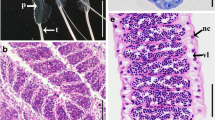Synopsis
Testis and ovary structure was examined histologically in seven of the 19 species in the three tribes of the teleost fish family Phallostethidae, series Atherinomorpha. These diminutive species have testes in which spermatogonia are restricted to the distal ends of lobules, a diagnostic character of atherinomorphs. Sperm in the ovarian lumen and chorionic attachment filaments on eggs confirms observations that phallostethids are internally fertilizing and lay fertilized eggs. The immense number of sperm in ovarian cavities means that all, or nearly all, ovulated oocytes will be fertilized. As revealed in histological sections, testicular ducts in most phallostethids examined contain ‘granular’ secretions that have not been reported in any other atherinomorphs. Species in the tribes Neostethini and Gulaphallini form unique spermatozeugmata that differ from those of other internally fertilizing atherinomorphs examined in that they have sperm nuclei that are oriented towards one side of the sperm bundle. Spermatozeugmata are not formed in species in the tribe Phallostethini. A unique spermatozeugmatum is interpreted as being a diagnostic character of phallostethids that has been lost or modified in phallostethins. Gonads of phallostethids and hypothesized close relatives are posterior and posteroventral to the gut rather than dorsal to the gut, as they are in most other fishes. Museum specimens preserved over sixty-five years ago are as useful for demonstrating gonad histology as are those preserved in the past few years.
Similar content being viewed by others
References cited
Duncker, G. 1904 Der Fische der malayischen Halbinsel Mitt. Nat. Mus. Hamburg 21: 133–207.
Grier, H.J. 1981 Cellular organization of the testis and spermatogenesis in fishes Amer. Zool. 21: 345–357.
Grier, H.J. 1984. Testis structure and formation of spermatophores in the atherinomorph teleostHoraichthys setnai. Copeia 1984: 833–839.
Grier, H.J. 1992. Chordate testis: the extracellular matrix hypothesis. J. Exp. Zool. 261: 151–160.
Grier, H.J. 1993. Comparative organization of Sertoli cells including the Sertoli cell barrier. pp. 704–739.In: L.D. Russell & M.D. Griswold (ed.) The Sertoli Cell, Cache River Press, Clearwater.
Grier, H.J., J.R. Burns & J.A. Flores. 1981. Testis structure in three species of teleosts with tubular gonopodia. Copeia 1981: 797–801.
Grier, H.J. & B.B. Collette. 1987. Unique spermatozeugmata in testes of halfbeaks of the genusZenarchopterus (Teleostei: Hemiramphidae). Copeia 1987: 300–311.
Grier, H.J., J.M. Fitzsimons & J.R. Linton. 1978. Structure and ultrastructure of the testis and sperm formation in goodeid teleosts. J. Morphol. 156: 419–438.
Grier, H.J., J.R. Linton, J.F. Leatherland & V.L. deVlaming. 1980. Structural evidence for two different testicular types in teleost fishes. Amer. J. Anal. 159: 331–345.
Grier, H.J., D.P. Moody & B.C. Cowell. 1990. Internal fertilization and sperm morphology in the brook silverside,Labidesthes sicculus (Cope). Copeia 1990: 221–226.
Ivantsoff, W., B. Said & A. Williams. 1987. Systematic position of the family Dentatherinidae in relationship to Phallostethidae and Atherinidae. Copeia 1987: 649–658.
Kulkarni, C.V. 1940. On the systematic position, structural modifications, bionomics, and development of a remarkable new family of cyprinodont fishes from the province of Bombay. Rec. Indian Mus. (Calcutta) 42: 379–423.
Manacop, P.R. 1936. A new phallostethid fish with notes on its development. Philipp. J. Sci. 59: 375–381.
Munro, A.D. & E.Y.M. Mok. 1990. Occurence [sic] of the phallostethid fishPhenacostethus smithi Myers in southern Johor, Peninsular Malaysia, with some observations on its anatomy and ecology. Raffles Bull. Zool. 38: 219–239.
Parenti, L.R. 1981. A phylogenetic and biogeographic analysis of cyprinodontiform fishes (Teleostei, Atherinomorpha). Bull. Amer. Mus. Nat. Hist. 168: 335–557.
Parenti, L.R. 1984. On the relationships of phallostethid fishes (Atherinomorpha), with notes on the anatomy ofPhallostethus dunckeri Regan, 1913. Amer. Mus. Novit. 2779: 1–12.
Parenti, L.R. 1986a. Bilateral asymmetry in phallostethid fishes (Atherinomorpha), with description of a new species from Sarawak. Proc. Calif. Acad. Sci. 44 (12): 225–236.
Parenti, L.R. 1986b. Homology of pelvic fin structures in female phallostethid fishes (Atherinomorpha, Phallostethidae). Copeia 1986: 305–310.
Parenti, L.R. 1986c. The phylogenetic significance of bone types in euteleost fishes. Zool. J. Linn. Soc. 87: 37–51.
Parenti, L.R. 1989. A phylogenetic revision of the phallostethid fishes (Atherinomorpha, Phallostethidae). Proc. Calif. Acad. Sci. 46: 243–277.
Parenti, L.R. 1993. Relationships of atherinomorph fishes (Teleostei). Bull. Mar. Sci. 52: 170–196.
Quintero-Hunter, I., H.J. Grier & M. Muscato. 1991. Enhancement of histological detail using metanil yellow as counterstain in periodic acid Schiff's hematoxylin staining of glycol methacrylate tissue sections. Biotech. Histochem. 66: 169–172.
Regan, C.T. 1913.Phallostethus dunekeri, a remarkable new cyprinodont fish from Johore. Ann. Mag. Nat. Hist. 12: 548–555.
Regan, C.T, 1916. The morphology of the cyprinodont fishes of the subfamily Phallostethinae, with description of a new genus and two new species. Proc. Lond. Zool. Soc. 1916: 1–26.
Roberts, T.R. 1971a. Osteology of the Malaysian phallostethid fishCeratostethus bicornis, with a discussion of the evolution of remarkable structural novelties in its jaws and external genitalia. Bull. Mus. Comp. Zool. 142: 393–418.
Roberts, T.R. 1971b. The fishes of the Malaysian family Phallostethidae (Atheriniformes). Breviora 374: 1–27.
Rosen, D.E. 1964. The relationships and taxonomic position of the halfbeaks, killifishes, silversides, and their relatives. Bull. Amer. Mus. Nat. Hist. 127: 217–268.
Rosen, D.E. & L.R. Parenti. 1981. Relationships ofOryzias, and the groups of atherinomorph fishes. Amer. Mus. Novit. 2719: 1–25.
Smith, H.M. 1927. The fishNeostethus in Siam. Science 65: 353–355.
Villadolid, D.V. & P.R. Manacop. 1934 (issued 1935). The Philippine Phallostethidae, a description of a new species, and a report on the biology ofGulaphallus mirabilis Herre. Philippine J. Sci. 55:193–220.
White, B.N., R.J. Lavenberg & G.E. McGowen. 1984. Atheriniformes: development and relationships. pp. 355–362.In: H.G. Moser, W.J. Richards, D.M. Cohen, MY Fahay, A.W. Kendall, Jr. & S.L. Richardson (ed.) Ontogeny and Systematics of Fishes, Amer. Soc. Ichthyol. Herp. Spec. Publ. No. 1, Lawrence.
Author information
Authors and Affiliations
Rights and permissions
About this article
Cite this article
Grier, H.J., Parenti, L.R. Reproductive biology and systematics of phallostethid fishes as revealed by gonad structure. Environ Biol Fish 41, 287–299 (1994). https://doi.org/10.1007/BF02197850
Received:
Accepted:
Issue Date:
DOI: https://doi.org/10.1007/BF02197850




